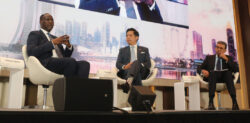By R. Esi Asante (PhD)
Different perspectives, diverse ideologies and philosophies, varying worldviews, conflicting mindsets and different belief systems and mindsets; these are but a few ways in which generational differences manifest.
Variations in values, attitudes and behaviours among generations, have greatly impacted the way society functions.
These differences have impacted various social dynamics including lifestyles, communication and work styles, and mindsets.
Individual differences are responsible for existing conflicts between different generations, leading to misunderstandings in various domains.
These differences are extended to the family and workforce. Family heads and leaders in the workplace have had tough times dealing with the differences and trying to harness them for cohabitation and effective outcomes.
If not managed, generational conflicts can lead to strained relationships and lost opportunities for mutual co-existence.
Diversity has become a buzz word in the world of work and there is a call for the inclusion of people from a range of different social and ethnic backgrounds and of different genders, age, social class, physical ability or attributes, religious or ethical values, national origin and political beliefs among others.
In this article, I delve into generational differences and conflicts generally and how this can be harnessed for maximum productivity.
Generational differences
Generations are a group of individuals born and living simultaneously. According to the Cambridge dictionary, generation is all the people of about the same age within a society or within a particular family, or the usual period of time from a person’s birth to the birth of their children. It is also a body of persons, constituting a single step in the line of descent from an ancestor.
In biology and demography, generation time is the average time between two consecutive generations in the lineages of a population. In human populations, generation time typically has ranged from 20 to 30 years, with wide variation based on gender and society (Wikipedia, 2025).
Social generations are cohorts of people born in the same date range and who share similar cultural experiences. There are psychological and sociological dimensions in the sense of belonging and identity which may define a generation.
Each generation are characterized by different time horizons and environments and affected by various events. Accordingly, there have been huge variations in generational choices and or preferences (Inglehart, 1997; Aydemir, Dinç & Cağlar, 2016).
This assertion is backed by the generational cohort theory, developed by Karl Mannheim in 1923 which suggests that individuals born within a similar timeframe and sharing formative experiences develop similar values, beliefs, and behaviors.
It also explains how generations under normal circumstances share values and viewpoints of the world, and how a generation tends to vary from one another.
This suggests that the understanding each generation has about this world differs and these differences shape their opinions, which also have an impact on the behaviours and expectations of each generational cohort at the workplace (Kapoor & Solomon, 2011).
While all generations have similarities, there are differences among them as well. The variations can be seen in work relationships and expectations, communication styles, technological proficiency and knowhow, career advancement, values and attitudes, conflicts, creativity and innovation and productivity.
There is no uniformity of judgment among academics, and membership in one group or the other may also depend on place of birth or sociocultural background, with each generation growing up in different socio-economic and technological perspective, shaping their worldview and behaviour.
However, the most commonly identified generations include the five generations currently in the workforce as explained by Dr. Bourne, an expert on generational differences at Purdue University Global, and an emerging generation:
- The Traditionalists or Silent Generation. They are born between 1925 – 1945. Referred to as the silent generation, some still serving on boards, bound by duty and discipline, shaped by the great depression, world War 11, radios and movies. This generation is dependable, straightforward, tactful and loyal. They are motivated by respect, recognition, providing long-term value to organisations with a worldview of obedience over individualism, considering age as equal to seniority and advancing through the hierarchy. Their communication is characterized by handwritten notes instead of emails.
- Baby Boomers. They are born between 1946 – 1964. They form 12 percent of the current workforce, are optimistic, competitive, workaholics, team-oriented, upholding values such as loyalty, stability and legacy. This generation is shaped by the Vietnam War, Civil Rights Movement, and Watergate. Their motivation is loyalty, teamwork and duty. They communicate efficiently using telephones and face-to-face and hold the worldview that achievement comes after paying one’s dues, stressing on sacrifice for success. Research shows that about 49 percent of these baby boomers are working past age 70 or plan to retire soon.
- Generation X. These are born between 1965 and 1980, flexible, informal, skeptical and independent. They are also autonomous and pragmatic, shaped by the HIV/AIDs epidemic, the fall of the Berlin Wall, the dot-com boom; motivated by diversity, work-life balance, personal professional interests rather than others. They maintain efficient communication including phone calls and face-to-face, favour diversity, quick to move on if their employer fails to meet their needs, and resistant to change especially if it affected their personal lives. Researchers contend that by 2028, this generation will outnumber baby boomers.
- Millennials. This generation is born between 1981 – 2000, competitive, civic but open-minded and achievement oriented. They are also purpose driven, collaborative and growth-oriented. They are shaped by Columbine, 9/11, and the internet. Their motivation is responsibility, quality of work and unique work experiences. They communicate with text messages and emails. They seek challenge, growth and development, cherish work-life balance and likely to leave an organization if they don’t like change. Researchers note that 75% of the global workforce will be made up of Millennials by 2025.
- Generation Z. Born between 2001 – 2020, this generation are global, entrepreneurial, progressive and less focused. They value transparency and inclusion, and they are tech-native. Shaped by life after 9/11, the Great Recession and access to technology from a young age, the global financial crisis, accelerated climate change, the birth of TikTok and the COVID pandemic, they are motivated by diversity, personalization, individuality and creativity. They communicate via social media, texts and instant messaging and have a self-identity as digital device addicts, they value independence and individuality, and prefer to work with Millennial managers, they are innovative coworkers and new technologies. About 67% of Generation Z’s want to work at companies where they can learn skills to advance their careers,
- Generation Alpha. This is an emerging generation, born post 2012. This generation is also known as Screenagers. They are digital natives with entrepreneurship mindset and shaped by artificial intelligence. They are the emerging workforce, digital first, fast learning entrepreneurs.
Conflict and Consequences of generational differences
The key areas of generational differences span communication styles and breakdown, work ethic and expectations, technological proficiency, career progression, values and attitudes, and the potential for innovation and creativity. They cause friction but present valuable opportunities for adaptation and growth.
For instance, research shows that younger generations, prefer digital styles like instant messaging and social media messaging, while the older generations prefer personal interaction.
Perceived disrespect and misunderstanding may arise when these generations clash. Boomers may consider short slack messages as abrupt or unprofessional, while Gen Z may find long email chains inefficient or outdated.
Baby boomers may value long hours at work and loyalty, while Gen X and Z may prioritize work-life balance, flexible work arrangements and opportunities for continuous learning. Older generations may judge younger ones as less committed, while younger workers may see older practices as toxic or unsustainable.
Younger generations are generally digital natives, while the older generations may be more comfortable with traditional methods, prone to resist change. Workflow frustrations, resistance to digital transformation, and a sense of exclusion for older workers can occur.
Baby boomers and Gen X may prioritize career ladder climbing, while Millennials and Gen Z may focus on skill development and job hopping.
Conflicts over “paying dues” versus “earning it quickly,” may arise leading to frustration and disengagement. Different generations hold varying beliefs about success, leadership, and the role of work in their lives. While younger generations might be seen as “entitled” or lacking work ethic, older generations might be viewed as “rigid” or resistant to change.
Boomers and Gen X might view “no news as good news,” whereas Millennials and Gen Z vigorously seek frequent, quick feedback and praise. Younger employees may feel undervalued or unsupported, while older workers may find the need for constant feedback excessive or time-consuming.
Harness Generational Differences
To address the conflicts researchers have suggested the need to promote awareness training, encourage broad communication norms, leverage intergenerational mentorships, create hybrid work models, institute diverse feedback systems and facilitate open dialogue about values and expectations.
These strategies can reduce generational conflicts and lead to richer collaboration, creativity and productivity.
Promoting cross generational collaboration by encouraging mentorship and reverse mentorship programs is needed.
Older generations in traditional mentorship pass down institutional knowledge and experience, while younger generations in a reverse mentorship, can share insights on digital tools, social trends and innovation.
The shared interactions can reduce generational friction and create respect across age groups.
Researchers call for the customization of communication styles by encouraging adaptability in communication to reduce misunderstandings and improve productivity. The possibility of offering flexible work structures and building general decision-making spaces can offer distinctive insights which can result in experienced decisions.
Modifying motivation and rewards according to the needs of generations is suggested. Subsequently, hybrid models or personalized work arrangements. feasible to accommodate a range of preferences and boost morale, must be offered.
Reward systems should be designed to offer a mix of recognition, growth opportunities, and work-life support in a bid to motivate the generations differently, based on their peculiar preferences. Leaders and managers should be equipped with skills to mediate intergenerational conflicts that arise, to reduce turnover and improve team performance.
Harnessing generational differences requires intentionality: promoting diversity and creating structures that promote collaboration. It can lead to higher innovation, better problem-solving, and a stronger organizational culture.
Unresolved generational conflicts, can lead to negative consequences in both workplaces and societal settings. Productivity and efficiency may suffer. Delayed tasks, misunderstanding and resistance or conflicting priorities can surface among several other consequences.










